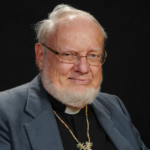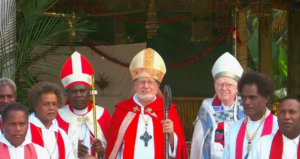
Bishop Terry Brown (1944-2024) quietly and determinedly changed the world, an unusual outcome, perhaps, of a Trinity College education. Terry arrived at the College in 1971, having completed conscientious objector service as a medic in the US Army in Japan. Terry lived out his life as a devout Anglo-Catholic dedicated to ecumenism, as a missionary committed to decolonization, as a gay man respected and trusted by his brother bishops in Asia and the Pacific, and as a church leader who furthered both social justice and congregational growth.
In a recent autobiographical essay[1], Terry attributed his understanding of global mission to his study under Cyril Powles, who had just started as Trinity’s church history professor after decades as a teacher and pastor in the Nippon Sei Ko Kai. Terry took Cyril’s “Third World Christianity” course, in which Cyril developed a theology of mission that grew out of the emerging anticolonial perspective of the 1960’s and which aligned closely with the “Mutual Responsibility and Interdependence” direction set by the global Anglican Congress held in Toronto in 1963. The course moved him to seek Cyril’s advice on whether he should go back to Japan to teach. Cyril said no.
Unable to pursue ordination in the Diocese of Michigan due to what he called his “dodgy sexuality”, his opposition to the Vietnam War, and his leftist politics [2], Terry was ordained deacon by the Bishop Harold Nutter of Fredericton in 1974 in a smoky liturgy in the college chapel, shockingly assisted by a woman, (then) Deacon Alyson Barnett, a clear sign of Terry’s lifelong support for women in ministry and unwillingness to compromise his vales. He briefly served a curacy in Moncton.
He was soon appointed by the World Mission Program to be lecturer in theology at Bishop Patteson Theological College in the Church of Melanesia from 1975-1981. Once there, he immersed himself in the life of the people around him, growing deeper roots, until he realized that he would need to leave.
Terry returned to Trinity College from 1981-5 in order to complete a doctorate under Cyril, in which he focused on the Anglo-Catholic Marxist theologian, F. Hastings Smyth founder of the Society of the Christian Commonwealth. He took up residence in a large house near St. Barnabas, full of Trinity College MDiv and ThD students, all of who remained lifetime friends. He wrote articles satirizing professors, churches and clerics for a mimeographed student paper.
Together with his friend and fellow doctoral student, Chris Lind, Terry edited Justice as Mission. As Anne Elliot, Chris Lind’s widow has written, “Terry understood that the essays were controversial and provocative, covering subjects such as neo-colonialism in Third World churches, cultural imperialism in Christian mission, communication across class barriers, and the failure of traditional models of theological education. He was … committed to the essays [on] Christian feminist critiques of mission, facing issues such as sexist language in worship, patriarchal hierarchies, the role of women’s groups in the Church and the relation between ordained and lay women’s ministries.”[3]
There were no suitable academic positions available when he completed his degree, so he accepted a position as the director of East Asian Mission and Development Coordinator at Church House. Together with David Hamid and John Rye, the ‘Three Musketeers of Canadian Anglican mission’, and under the leadership of Ellie Johnson, he was able to implement the church’s commitment to mission as mutual partnership. He maintained a relationship with the college during this decade, teaching a course in the theology of missions. And then it was time to move on.
In late 1995, an official with the Diocese of Malaita approached Terry to ask if he would put his name forward for bishop. The diocese was in crisis, and the islands themselves were increasingly strife-torn. After much soul searching, he believed that he would not become their oppressor. He would be paid at the local scale, and he would be working with people he had known for 20 years, some of whom had named their children after him. “Finally, I decided that if they wanted me they could have me.”[4] He was elected on January 25, the Feast of St. Paul, and consecrated on Pentecost 1996. The congregation numbered in the thousands.
As a bishop, Terry practiced mutual hospitality: he stayed with the faithful, and the faithful lived with him. He visited the most remote congregations, built up a rural training centre and a health centre. Under his leadership, four religious communities thrived, he ordained dozens of deacons and priests, confirmed eleven thousand candidates, and created specialized training programs for women, youth, chiefs and catechists.
All was not sunny and bright: from 1998-2003, the Solomons experienced armed conflict between unofficial provincial militias. The churches banded together to assist the people and to call for peace. Seven members of the Melanesian Brotherhood, an Anglican order devoted to making peace, were martyred when they attempted to persuade a militant to lay down his arms. A few weeks later, perhaps as a response to the slayings, the Australian government intervened, and the conflict began to die down. Terry’s role as leader, reconciler and peace maker was central throughout this period.
In 2008, he retired from the episcopacy but remained in Honiara until 2012, working as an archivist for Church of Melanesia. He was also closely involved in the Truth and Reconciliation Commission’s work after the violence had finished and edited the Final Report. (In 2013, when the government attempted to bury it, Terry simply released it.) In 2012, he returned to Canada, where he served as the priest and pastor of the Church of the Ascension in Hamilton. He retired again in 2020, and became an honourary assistant at Christ’s Church Cathedral. His life was full of friends, meals and visits.
Three characteristic activities persisted throughout the last 12 years of Terry’s life: he taught at Trinity College, he returned to the Solomon Islands every few years, and he worked to expand and animate the work of the Canadian Church Historical Society.
On Palm Sunday, Terry returned to the Church of the Ascension to preach what was to be his last sermon, on kenosis, or self-emptying. Sadly, he died days before “MRI at 60: Mutual Responsibility and Interdependence”, a conference held at the college, which he had helped to organize and which he had been working on immediately before his death, a conference designed to reconsider the meaning of MRI in a contemporary context.
After his requiem at the Christ’s Church Cathedral, his ashes were brought back to the Solomons for burial among the people he loved.
Terry’s faithfulness, generosity, humour, intelligence and kindness allowed him to create a life in which mission was lived out as partnership and friendship. We can hope he was not the last of his kind.
— Dr. Alison Kemper, MDiv ’79, DTh ’87, PhD (Rotman) ’12

[1] Brown, Terry. 2023. “Partnership to Friendship: How a Canadian Anglican Priest Became a Bishop in the South Pacific.” In Partnership as Mission: Essays in Memory of Ellie Johnson, 289. Wipf and Stock Publishers. Terry’s essay conveys both his character and his remarkably acute observations of 60 years of Anglican history.
[2] Richard Mammana. “Terry Brown, Bishop in Four Worlds”. Apr 4, 2024 https://medium.com/@richard.mammana/terry-brown-bishop-in-four-worlds-863095576357 Mammana’s obituary is comprehensive, intimate and fascinating.
[3] Anne Elliott. Unpublished correspondence. April 26, 2024
[4] Terry Brown. op. cit. p. 75
